| Calyptocarpus vialis | |
|---|---|

| |
| Conservation status | |
 Secure (NatureServe) | |
| Scientific classification | |
| Kingdom: | Plantae |
| Clade: | Tracheophytes |
| Clade: | Angiosperms |
| Clade: | Eudicots |
| Clade: | Asterids |
| Order: | Asterales |
| Family: | Asteraceae |
| Genus: | Calyptocarpus |
| Species: | C. vialis |
| Binomial name | |
| Calyptocarpus vialis Less., 1832 | |
| Synonyms | |
| |
Calyptocarpus vialis is a species of flowering plant in the family Asteraceae. Common names for C. vialis include straggler daisy, horseherb, lawnflower, and creeping Cinderella-weed. It is native to south Texas, Mexico, Belize, Venezuela, and the Caribbean. It has also been introduced east of Texas, Argentina, Hawaii, India, Java, Australia, and Taiwan. It is one of only three species in the genus Calyptocarpus.
The opposite leaves are typically 1–3 cm (0.39–1.18 in) long and triangular to lanceolate in shape. It bears heads of yellow flowers, with around 10–20 disc florets and 3–8 ray florets, the laminae of the latter around 2–5 mm (0.079–0.197 in) long. It flowers year round. It is a weedy species, found in lawns and along other disturbed areas such as roadsides and paths.
Calyptocarpus vialis possess medicinal properties that are as effective as the antibacterial drug ciprofloxacin. Additionally, Calyptocarpus vialis extracts are more effective against fungal stains than the standard market drug. With further research and development, Calyptocarpus vialis can be crucial in developing medications for various diseases.
References
- NatureServe. "Calyptocarpus vialis". NatureServe Explorer. Arlington, Virginia. Retrieved 22 January 2025.
- ^ "Calyptocarpus vialis Less". Plants of the World Online. Plants of the World Online | Kew Science. Retrieved 2020-01-03.
- Calyptocarpus vialis. Lady Bird Johnson Wildflower Center. University of Texas, Austin.
- "Calyptocarpus vialis". Germplasm Resources Information Network. Agricultural Research Service, United States Department of Agriculture. Retrieved 25 January 2018.
- ^ Strother, John L. (2006). "Calyptocarpus vialis". In Flora of North America Editorial Committee (ed.). Flora of North America North of Mexico (FNA). Vol. 21. New York and Oxford: Oxford University Press. Retrieved 5 January 2020 – via eFloras.org, Missouri Botanical Garden, St. Louis, MO & Harvard University Herbaria, Cambridge, MA.
- Strother, John L. (2006). "Calyptocarpus". In Flora of North America Editorial Committee (ed.). Flora of North America North of Mexico (FNA). Vol. 21. New York and Oxford: Oxford University Press. Retrieved 5 January 2020 – via eFloras.org, Missouri Botanical Garden, St. Louis, MO & Harvard University Herbaria, Cambridge, MA.
- ^ Bachhar, Vishwajeet; Joshi, Vibha; Shekher Mishra, Shashank; Shukla, Ravi K.; Bhargava, Samir; Duseja, Manisha (2024-09-18). "In‐Vitro Antimicrobial, Antidiabetic and Anticancer Activities of Calyptocarpus Vialis Extract and its Integration with Computational Studies". ChemistrySelect. 9 (35). doi:10.1002/slct.202401414. ISSN 2365-6549.
| Taxon identifiers | |
|---|---|
| Calyptocarpus vialis |
|
This Heliantheae article is a stub. You can help Misplaced Pages by expanding it. |
